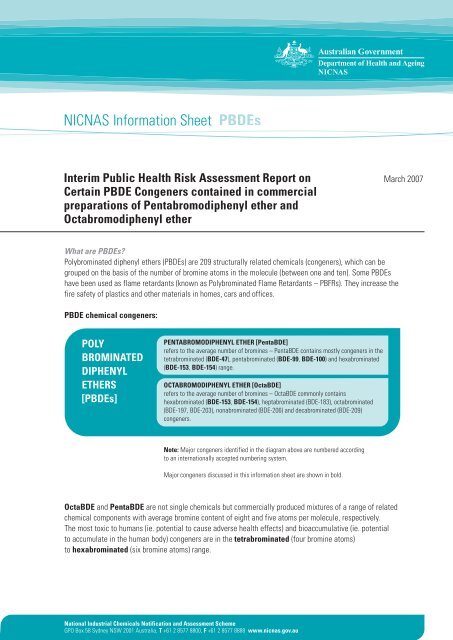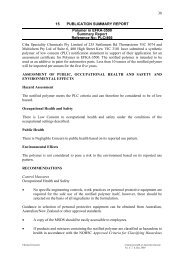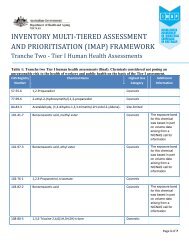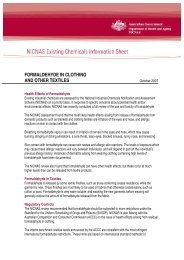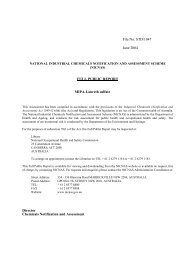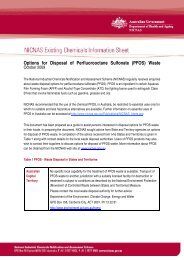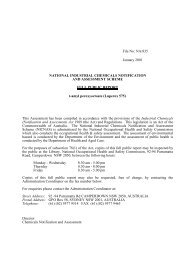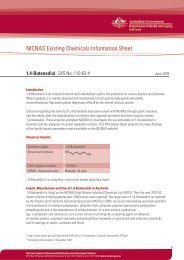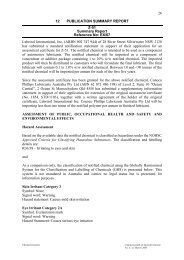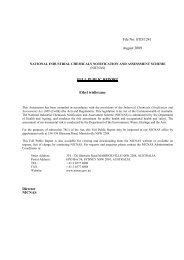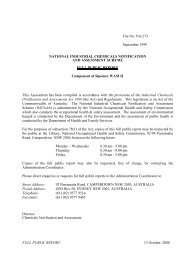NICNAS Information Sheet PBDEs
NICNAS Information Sheet PBDEs
NICNAS Information Sheet PBDEs
Create successful ePaper yourself
Turn your PDF publications into a flip-book with our unique Google optimized e-Paper software.
<strong>NICNAS</strong> <strong>Information</strong> <strong>Sheet</strong> <strong>PBDEs</strong><br />
Interim Public Health Risk Assessment Report on<br />
Certain PBDE Congeners contained in commercial<br />
preparations of Pentabromodiphenyl ether and<br />
Octabromodiphenyl ether<br />
What are <strong>PBDEs</strong>?<br />
Polybrominated diphenyl ethers (<strong>PBDEs</strong>) are 209 structurally related chemicals (congeners), which can be<br />
grouped on the basis of the number of bromine atoms in the molecule (between one and ten). Some <strong>PBDEs</strong><br />
have been used as flame retardants (known as Polybrominated Flame Retardants – PBFRs). They increase the<br />
fire safety of plastics and other materials in homes, cars and offices.<br />
PBDE chemical congeners:<br />
POLY<br />
BROMINATED<br />
DIPHENYL<br />
ETHERS<br />
[<strong>PBDEs</strong>]<br />
PENTABROMODIPHENYL ETHER [PentaBDE]<br />
refers to the average number of bromines – PentaBDE contains mostly congeners in the<br />
tetrabrominated (BDE-47), pentabrominated (BDE-99, BDE-100) and hexabrominated<br />
(BDE-153, BDE-154) range.<br />
OCTABROMODIPHENYL ETHER [OctaBDE]<br />
refers to the average number of bromines – OctaBDE commonly contains<br />
hexabrominated (BDE-153, BDE-154), heptabrominated (BDE-183), octabrominated<br />
(BDE-197, BDE-203), nonabrominated (BDE-206) and decabrominated (BDE-209)<br />
congeners.<br />
Note: Major congeners identified in the diagram above are numbered according<br />
to an internationally accepted numbering system.<br />
Major congeners discussed in this information sheet are shown in bold.<br />
OctaBDE and PentaBDE are not single chemicals but commercially produced mixtures of a range of related<br />
chemical components with average bromine content of eight and five atoms per molecule, respectively.<br />
The most toxic to humans (ie. potential to cause adverse health effects) and bioaccumulative (ie. potential<br />
to accumulate in the human body) congeners are in the tetrabrominated (four bromine atoms)<br />
to hexabrominated (six bromine atoms) range.<br />
National Industrial Chemicals Notification and Assessment Scheme<br />
GPO Box 58 Sydney NSW 2001 Australia, T +61 2 8577 8800, F +61 2 8577 8888 www.nicnas.gov.au<br />
March 2007
<strong>NICNAS</strong> <strong>Information</strong> <strong>Sheet</strong> <strong>PBDEs</strong><br />
Uses<br />
PentaBDE has predominantly been used in polyurethane materials such as furniture foams. OctaBDE<br />
is mostly used in acrylonitrile/butadiene/styrene (ABS) hard plastics in computer casings and in electrical<br />
products such as power point fronts, light switches and electrical connections.<br />
Regulatory activity by <strong>NICNAS</strong> in 2001 has seen the Australian use of these two chemicals decline<br />
significantly. PentaBDE and OctaBDE are not manufactured in Australia and available information indicates<br />
that no import of either chemical has occurred since mid 2005.<br />
Regulatory Status<br />
OctaBDE and PentaBDE were declared Priority Existing Chemicals (PECs) for full risk assessment under<br />
the Industrial Chemicals (Notification and Assessment) Act 1989 (the Act).<br />
As per the notice in the Chemical Gazette of 6 February 2007 octaBDE is no longer a PEC as it was removed<br />
from the Australian Inventory of Chemical Substances (AICS). Manufacture and importation of octaBDE is also<br />
not permitted under the <strong>NICNAS</strong> exemption categories except as laboratory standards for analytical<br />
determination. Persons importing octaBDE for analytical purposes must comply with annual reporting<br />
obligations as required under the Act.<br />
Interim assessment outcomes<br />
Recent Australian studies determined PBFR levels in breast milk, blood, aquatic sediments and indoor<br />
environments. This data indicated that the overall levels of <strong>PBDEs</strong> in Australian breast milk were low,<br />
consistent with those reported internationally. Highest levels of <strong>PBDEs</strong> in blood in Australia were detected<br />
in young children (0-4 years of age) and lower levels in women of childbearing age.<br />
Importantly, there is no evidence of any adverse health effects in newborns, children or adults from exposure<br />
to <strong>PBDEs</strong>. Public health risk determinations were undertaken to assess the more toxic and bioaccumulative<br />
congeners (tetra to hexabrominated range) found in PentaBDE and OctaBDE. In determining risk, <strong>NICNAS</strong><br />
adopted a highly conservative approach using “worst-case” risk assessment parameters. Results from<br />
Australian biomonitoring studies for a particular subpopulation of concern were compared with results<br />
in laboratory rats and mice. This highly conservative approach was used in the absence of information<br />
to quantify the uncertainties in the risk assessment.<br />
While the highest levels of <strong>PBDEs</strong> were detected in young children, a conservative risk assessment indicated<br />
that this group was not at greatest risk of adverse health effects from exposure to congeners found in<br />
PentaBDE and OctaBDE.<br />
Blood levels of these congeners detected in women of childbearing age do not pose a risk to the women<br />
themselves. However, the risk assessment indicated a potential risk of neurodevelopmental effects in the<br />
offspring from maternal exposure, based on results from laboratory animals.<br />
As a result of the risk assessment, the regulator is adopting a precautionary approach by immediately<br />
prohibiting the import and/or manufacture of pentaBDE in Australia, pending the outcome of a full risk<br />
assessment. As indicated above introduction of octaBDE is already prohibited.<br />
National Industrial Chemicals Notification and Assessment Scheme<br />
GPO Box 58 Sydney NSW 2001 Australia, T +61 2 8577 8800, F +61 2 8577 8888 www.nicnas.gov.au
<strong>NICNAS</strong> <strong>Information</strong> <strong>Sheet</strong> <strong>PBDEs</strong><br />
International activity<br />
Introduction and use of OctaBDE and PentaBDE as a substance or in preparations at concentrations higher<br />
than 0.1% (including in articles) was banned in the European Union in 2004. OctaBDE and PentaBDE were<br />
also included in the EU Directive on Restriction of Hazardous Substances (RoHS – the Directive applicable to<br />
new electrical and electronic equipment) in 2006. Two manufacturers in the United States voluntarily phased<br />
out their manufacture at the end of 2004. Furthermore these two chemicals are currently being assessed for<br />
possible inclusion on the Stockholm Convention on Persistent Organic Pollutants.<br />
Questions:<br />
What are the benefits of <strong>PBDEs</strong>?<br />
Flame retardants are widely used to reduce the flammability potential of a range of products. Their use<br />
has made a significant contribution to the reduction in human life lost from fire over several decades.<br />
In addition to reducing the likelihood that an item will ignite, flame retardants inhibit the spread of a fire,<br />
and give occupants up to 15 times more escape time from a fire than they would have if flame retardants<br />
were not used.<br />
How could <strong>PBDEs</strong> affect health?<br />
Importantly, there is no evidence of any adverse health effects in newborns, children or adults,<br />
from exposure to <strong>PBDEs</strong>.<br />
Recent Australian studies indicate that the highest levels of <strong>PBDEs</strong> were detected in the blood of young<br />
children (0-4 years of age) and lower levels in women of childbearing age.<br />
While the interim risk assessment indicates a potential risk of developmental effects in the unborn child<br />
based on extrapolation from results in laboratory animals, this determination is based on a highly<br />
conservative risk assessment approach using “worst-case” assessment parameters.<br />
The overall levels of <strong>PBDEs</strong> found in breast milk are low and do not pose a risk to breast fed infants.<br />
Mothers should continue to breastfeed their babies.<br />
Can these chemicals be introduced into Australia in articles?<br />
It is possible that articles such as furnishing foams, hard plastics used in electrical equipment casings<br />
(eg. TV casings), circuit board laminates and electrical insulation containing Octa- and PentaBDEs may<br />
continue to be imported into Australia. However, the quantities of these chemicals in imported articles<br />
are expected to decline significantly due to the lack of commercial availability of these chemicals as<br />
a result of international regulatory action and voluntary activity by industry.<br />
To date the exact sources that contribute to environmental levels of <strong>PBDEs</strong>, particularly in the indoor<br />
environment, have not been identified. Further research is required to ascertain the presence of <strong>PBDEs</strong><br />
in specific articles in Australian homes and offices and the potential for release of these chemicals<br />
from articles.<br />
What is the Australian Government doing to address <strong>PBDEs</strong>?<br />
<strong>NICNAS</strong> is adopting a precautionary approach to the regulation of PentaBDE by immediately prohibiting<br />
the import and/or manufacture of the chemical in Australia. The immediate prohibition of the introduction<br />
of the chemical will prevent the introduction of commercial products from overseas and protect human<br />
health and safety. This prohibition is consistent with international regulatory activity.<br />
National Industrial Chemicals Notification and Assessment Scheme<br />
GPO Box 58 Sydney NSW 2001 Australia, T +61 2 8577 8800, F +61 2 8577 8888 www.nicnas.gov.au
<strong>NICNAS</strong> <strong>Information</strong> <strong>Sheet</strong> <strong>PBDEs</strong><br />
Questions (continued):<br />
OctaBDE was removed from the Australian Inventory of Chemical Substances (AICS) on 6 February 2007.<br />
Manufacture and/or importation of octaBDE will require notification to and assessment of the chemical<br />
by <strong>NICNAS</strong>. Manufacture and importation of octaBDE is also not permitted under the <strong>NICNAS</strong> exemption<br />
categories except as laboratory standards for analytical determination. Persons importing octaBDE for<br />
analytical purposes must comply with annual reporting obligations as required under the Industrial<br />
Chemicals Notification and Assessment Act.<br />
<strong>NICNAS</strong> will commission a study to determine the sources of these chemicals in domestic dwellings and<br />
offices. This information will be incorporated into the full risk assessment of PentaBDE (expected to be<br />
completed by mid 2007) and will assist in determining the need for further regulatory action.<br />
The Australian Government Department of the Environment and Water Resources is investigating the<br />
potential for Australia to harmonise with the EU Directive on the restriction of certain hazardous<br />
substances in electrical and electronic equipment (RoHS Directive), which would ban the use of Octaand<br />
PentaBDEs in such equipment.<br />
National Industrial Chemicals Notification and Assessment Scheme<br />
GPO Box 58 Sydney NSW 2001 Australia, T +61 2 8577 8800, F +61 2 8577 8888 www.nicnas.gov.au


